art
Urhobo
Exhibit Connects Art, Spirit
A
review of Where Gods and Mortals Meet, on view at the Columbia
Museum of Art through Jan. 15.
By Mary Bentz Gilkerson
 |
|
Bruce Onobrakpeya, Agbogidi (A Study of Fertility Shrines) |
It's rare for the Columbia Museum of Art to host an exhibit of non-Western Art. That's all changing with Where Gods and Mortals Meet: Continuity and Renewal in Urhobo Art.
The exhibition is the first to closely examine the art of the Urhobo people. Put together by Perkins Foss, who has studied the culture since the 1960s as guest curator for the Museum for African Art in New York, the exhibition presents more than 80 artworks, photographs, video and audio recordings of cultural performances from the 19th century to the present.
The Urhobo are a people of the Niger River Delta in southern Nigeria, an area between two powerful rivers. Imagery of water and the deep surrounding forests have played an ongoing part in their art, religion and culture.
This, however, is not simply another anthropological look at art by "others." This exhibit goes to great lengths to contextualize the artwork ‹ not to demystify it for the viewer, but to maintain the mystery that is a part of art in traditional cultures.
In addition to traditional artworks such as monumental woodcarvings, metal and clay sculptures, carved and woven masks and costumes, the exhibition also includes contemporary pieces by Urhobo artists. A number of the creators of traditional works are living artists who have consciously chosen to continue working in the customary ways.
One of the great attractions of art from traditional cultures is the connection between the artwork and the communal belief system it supports. As a culture, we desperately feel the need to experience belief again, if not directly through our own communal system (our lack of which disturbs us), then at least vicariously through someone else's.
Walking into the back of the gallery leads the viewer into a forest of figures. Tall wooden carvings fill the central space but are dwarfed by the immense figures along the back wall. These over-life-size figures, representing ancestor spirits, form a bridge between the human world and the spirit world.
In fact, the connection between art and the social structure is not as intact as it first appears. The Urhobo are facing the same social crises as much of the rest of the world. With shifting economic patterns and political upheaval, the traditional way of life is challenged and fading. How to maintain a connection with the past in the midst of these crises is one of the issues addressed in the exhibit.
The fact is that the relationships among art, life and belief systems are organic, fluid and changing. Foss has done an excellent job capturing this fluidity in the works that he has selected.
Contemporary Urhobo artist Bruce Onobrakpeya is one of the most successful artists not only in Nigeria, but also in all of Africa. He draws on Urhobo myths and folklore for his sources and inspiration, but synthesizes them with Western styles and practices to make something uniquely his.
In prints that reflect the influence of Surrealism and Expressionism, Onobrakpeya pairs traditional symbolism with imagery from his own imagination. There's a certain irony in his use of these modes, given the heavy influence of African art on early 20th-century European art. I have the feeling that Onobrakpeya is very aware that he's bringing things full circle.
Emedjo is a large intaglio print that incorporates 49 smaller black-and-white prints into a large field of deep brown. The small individual prints resemble cards, like Tarot, each with a symbolic archetypal figure. While he uses traditional patterns and styles, the figures are his own creation. It's a fascinatingly complex piece.
In Ada Erinvbin (Road to the Spirit World), Onobrakpeya depicts a man lying on the ground, hiding his face before the entrance to the spirit world, represented here by a blood-red path into the forest. While his symbolic use of color is Nigerian, as is the specific narrative he addresses, the meaning is as universal as Dante's adventure in the Dark Wood, indicating the desire to connect with meaning, to walk into the spirit world and to return to tell about it.